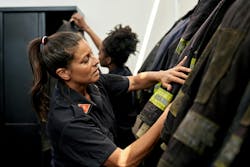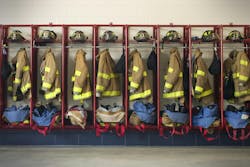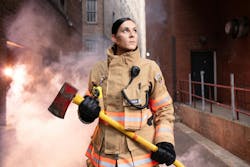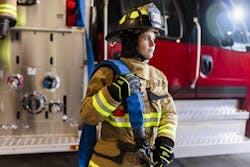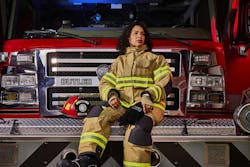Key Takeaways
- Incorrectly sized turnout coats and pants for firefighters can interfere with mobility and introduce unnecessary risks.
- Firefighter PPE’s capability to protect against heat, moisture and abrasion depends not only on the materials out of which it’s constructed but also on how the PPE interacts with the body through movement.
- A performance-based, heterogenous sizing model for firefighter PPE centers on torso length, shoulder width and waist-to-hip ratios.
When a fire department decides to purchase new PPE, part of the selection process typically includes a wear trial. Firefighters are measured, fitted and given the opportunity to test PPE that meets current certification standards. The objective is to ensure comfort, mobility and safety before a purchase for the entire department is made. However, the process isn’t perfect.
There’s growing recognition that existing sizing systems might not suit the needs of the modern firefighter workforce. Although more women continue to enter the profession, much of the available PPE was developed based on older data that don’t reflect the full range of body types that are represented in the fire service today. Roughly 9 percent of U.S. firefighters are women, per NFPA, yet as many as 80 percent of women firefighters experience issues with improperly fitting PPE.
This isn’t about preference; it’s about performance. Incorrectly sized gear can interfere with mobility and introduce unnecessary risks in dire situations. As someone who has spent more than two decades testing and certifying first responder PPE, I believe improving fit for individual firefighters would have a significant positive effect. There are actionable strategies to help us to get there.
How fit affects function
Firefighter PPE is engineered carefully to protect against extreme heat, moisture, abrasion and other physical hazards. The effectiveness of this gear depends not only on the materials that are used but also on how it interacts with the body through movement. Sizing and fit are essential considerations.
When PPE is designed, it can be problematic when assumptions are made about where stress points fall, how layers will align and where protective air gaps will be maintained between the garment and the skin. These gaps help regulate temperature and provide critical insulation from heat. If a jacket fits too tightly across the chest or hips, it compresses the layers, which reduces thermal protection. If pants are too loose at the waist, they might sag or shift during climbing, lifting or crawling, which prohibits motion and slows down the firefighter.
Well-suited PPE is even more crucial in wildland scenarios, where firefighters might wear the same gear for 14–16 hours at a time. The wrong fit can lead to sustained discomfort, skin irritation or injury.
The sizing dilemma
The challenge begins with the data. Some of the female PPE sizing tables that are in use today were developed using decades-old anthropometric studies of military personnel. Although these data were of some value, they never were intended to represent the full spectrum of bodies that are in the fire service.
Even well-intentioned efforts to expand sizing options haven’t addressed the underlying issue in some cases. Creating a smaller or shorter version of gear that’s designed for the average firefighter doesn’t necessarily produce a proper fit for women nor for anyone whose proportions vary from the template.
Working toward a better fit
There are promising signs that design innovation is possible when more-tailored information is used. I attended the 2025 NFPA Conference & Expo to participate on a panel about the sizing challenges of PPE. The needs, research and progress toward development of PPE that better suits female firefighters were discussed. At the event, I was introduced to a manufacturer that collaborated with fashion design experts to develop female-firefighter-specific PPE. The response from the women who tried on the gear was very positive (fit, mobility and comfort all visibly improved), giving a glimpse into what the future can look and feel like for female firefighters.
Other initiatives are underway, too, including the Declaration on Gender-Responsive Standards and Standards Development, which is led by the United Nations Economic Commission for Europe. Global organizations, including UL Standards & Engagement, which is UL Solutions’ sister organization, have signed the declaration and committed to take actionable steps to increase the representation of women in standards development to better inform technical regulations and guidelines.
Efforts such as these that encourage collaboration, guided by accurate data and firefighter feedback, can result in PPE that fits better and performs more consistently across the whole department.
Rethink how to define sizing
A growing conversation within the industry focuses on the benefits of moving away from gender-specific sizing altogether. Instead of offering separate lines for men and women, manufacturers could adopt a performance-based, heterogeneous sizing model. This approach centers on measurements, including torso length, shoulder width and waist-to-hip ratios, rather than defaulting to binary labels.
This model already is used in other industries where precision fit is essential, such as construction and healthcare. Applying this to firefighting PPE would allow for a more nuanced range of sizes and better accommodation of different body types, regardless of gender.
Importantly, a performance-based approach also makes it easier for departments and purchasing agents to select gear that’s based on function and safety, rather than navigating two separate sizing systems. It encourages consistency across departments and promotes broader adoption of inclusive sizing in standards and procurement policies.
Research & representation
Investing in more targeted data collection and wear-testing can help the industry to design PPE that fits a wider range of firefighters. Access to updated, firefighter-specific anthropometric data would to support more-precise design decisions and lead to the development of gear that performs better in real-world conditions.
A national study that’s underway at Florida State University is providing active-duty U.S. female firefighters with step-by-step instructions to share their exact measurements. The goal is to collect as much data as possible to create one of the most comprehensive databases of female firefighter body measurements to date, to help to close long-standing data gaps in PPE design.
Equally important is participation in the standards-development process. Committees that develop standards, such as NFPA 1970: Standard on Protective Ensembles for Structural and Proximity Firefighting, Work Apparel, Open-Circuit Self-Contained Breathing Apparatus (SCBA) for Emergency Services, and Personal Alert Safety Systems (PASS) and NFPA 1950: Standard on Personal Protective Equipment for Technical Rescue Incidents, Emergency Medical Operations, and Wildland and Urban Interface Firefighting—which outline the performance, testing and certification requirements for PPE that’s used by first responders—rely on input from a wide range of stakeholders, including fire service professionals, engineers, manufacturers and researchers. Continued and increased engagement from these groups that have firsthand knowledge of fit issues can help to enhance future standards requirements to better reflect field conditions and today’s workforce.
Fit: A core design principle
There still is untapped potential in the way that sizing data are gathered, applied and standardized. Moving the needle requires consistent feedback from firefighters, more inclusive anthropometric data, and varied options for PPE to fit the individual who wears it day in and day out. The fire service continues to evolve. The assumptions that are behind how protective gear is built must evolve with it, because one size never has fit all.
Product Spotlight
Breathability & Flexibility
For too long, female firefighters have had to suffer turnout gear that’s designed for men, not for them. Fire-Dex believed that isn’t good enough. AeroFlex turnouts aren’t just a breakthrough in breathability and flexibility. They’re custom-built for a woman’s body type to provide the perfect fit, because all firefighters deserve to feel safe in their gear.
Space Without Extra Bulk
Designed specifically for the female form, Valkyrie from Viking Life-Saving Equipment features anatomical shaping in the chest, hips and shoulders to provide space without extra bulk for the mobility that’s essential to safety and performance. Developed with firefighter input, the line reflects years of research and real-world testing, because the company believes that gear that fits right protects better.
Comfort, Mobility & Protection
LION’s Fit For Her line delivers turnout gear that’s tailored to women. Thoughtful adjustments in inseam, sleeve and back length, along with added room at the hips and coat sweep and a smaller neckline, ensure a precise fit. The result: Greater comfort, mobility and protection for women firefighters at every call.
Product Spotlight
Breathability & Flexibility
For too long, female firefighters have had to suffer turnout gear that’s designed for men, not for them. Fire-Dex believed that isn’t good enough. AeroFlex turnouts aren’t just a breakthrough in breathability and flexibility. They’re custom-built for a woman’s body type to provide the perfect fit, because all firefighters deserve to feel safe in their gear.
FIREDEX.COM
Comfort, Mobility & Protection
LION’s Fit For Her turnout gear delivers turnout gear that’s tailored to women. Thoughtful adjustments in inseam, sleeve and back length, along with added room at the hips, coat sweep and a smaller neckline, ensure a precise fit. The result: Greater comfort, mobility and protection for women firefighters at every call.
LIONPROTECTS.COM
Space Without Extra Bulk
Designed specifically for the female form, Valkyrie from Viking Life-Saving Equipment features anatomical shaping in the chest, hips and shoulders to provide space without extra bulk for the mobility that’s essential to safety and performance. Developed with firefighter input, the line reflects years of research and real-world testing, because the company believes that gear that fits right protects better.
VIKING-LIFE.COM
About the Author

Amanda Newsom
Amanda Newsom is the principal engineer for PPE at UL Solutions. She has worked within the engineering team throughout her entire career, testing and certifying PPE for first responders, industrial workers and medical workers. Newsom represents UL Solutions on a number of NFPA, ASTM International and International Standards Organization technical committees, where she provides input throughout the standards development process.
